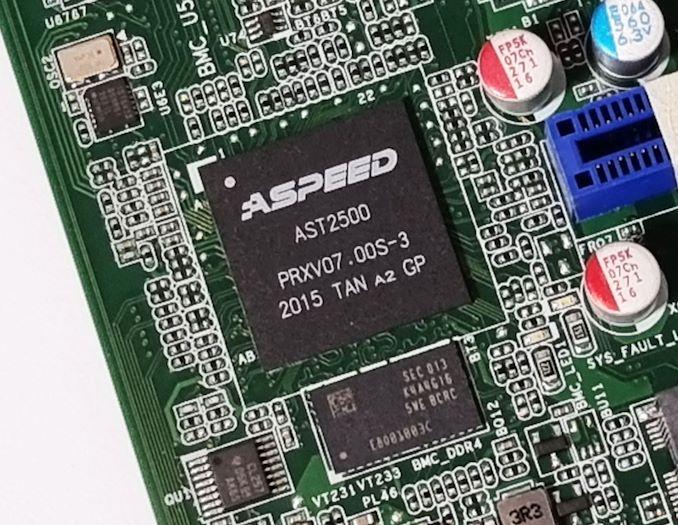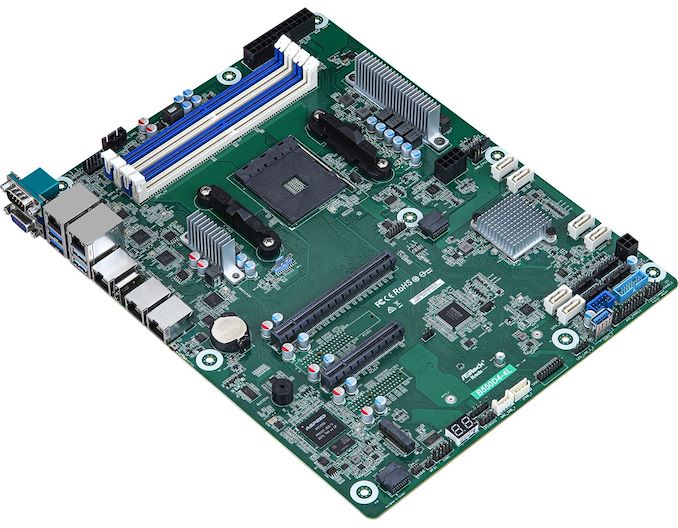ASRock Rack B550D4-4L Motherboard Review: B550 Goes Professional with BMC
by Gavin Bonshor on May 20, 2021 9:00 AM ESTConclusion
Not every motherboard is created equally, nor is every motherboard created with the same functionality as other models. Typically as seen on Intel platforms, it has its consumer-level chipsets such as B560, Z590, Z490, etc, but it also has a level pegged W480 chipset for professional users, which falls outside of its typical industrial level Xeon Scalable platform. Looking at AMD, it doesn't really do this with its desktop platforms, and users looking for workstation-level performance with consumer-level functionality can opt for Threadripper. The other options include Ryzen for desktop, and EPYC for enterprise, cloud, and server, with no real in-between.
When we first got wind of the ASRock Rack B550D4-4L back in January, it piqued our interest as it's the only known board to us that uses AMD's B550 desktop chipset to feature a BMC controller, in this case, an ASPEED AST2500, which is commonly used on professional level boards such as this. Another unique feature of the B550D4-4L is that it has four Intel Gigabit Ethernet ports on the rear, with a fifth designed to provide users access to the board's IPMI, for remote access purposes.
Being on an AMD Ryzen desktop platform, this allows users to use PCIe 4.0, with one full-length PCIe 4.0 x16 slot, and one half-length PCIe 4.0 x4 slot. Typically B550 boards only have one PCIe 4.0 slot, and this is where the B550D4-4L opts for a second PCIe 4.0 slot over a Gen 4 M.2 slot. Instead, the board has one PCIe 3.0 x4 M.2 slot, which supports SATA. As we know, the B550 chipset itself uses PCIe 3.0 lanes, and ASRock Rack is routing this through AMD's modular chipset and tracing to add the second PCIe 4.0 x4 half-length slot. Other storage options include six SATA ports, with four from the chipset with RAID 0, 1, and 10 support, and two via an ASMedia ASM1061 SATA controller.
Functionality and usability are two key parameters to look for in a server-focused model, and the B550D4-4L provides plenty of this, with an intuitive and accessible IMPI interface. We've highlighted that the ASRock Rack IPMI is functional in previous reviews, and the B550D4-4L is no different in this regard. There is also plenty of functionality within the firmware, with B550 specific options including access to AMD Ryzen's Precision Boost Overdrive settings, as well as an LN2 mode, which seems completely out of tune with the board's core values. We really wouldn't recommend overclocking a Ryzen 3000 or 5000 series desktop processor on this board, primarily due to the design of the 4+2 power delivery, and the inadequate heatsinks designed to cool it.

The ASPEED AST2500 BMC chip on the ASRock Rack B550D4-4L motherboard
Focusing on the performance, and the B550D4-4L was surprisingly competitive when compared to other B550 models, not just in our system testing, but in our computational benchmarks too. It has Precision Boot Overdrive (PBO) applied by default, which allowed our Ryzen 7 3700X processor to stretch its legs a little, especially when cooled with our Corsair H150i Elite Capellix 360 mm AIO cooler. The only negative in performance came in our DPC latency testing, with our results showing that this board isn't suitable for DAW systems. In the firmware, we did try setting the same settings as other B550 models on test, but no matter what we inputted in relation to memory settings, the latencies wouldn't change on our memory and resulted in DDR4-3200 with CL22 latencies; this would have a negative impact on general compute performance, but with DDR4-3200 CL16, we would expect it to be highly competitive with other models we've tested.
Final Thoughts
The ASRock Rack B550D4-4L at the time of writing is in a league of its own, with no other AMD B550 series motherboards offering a BMC controller. Another factor to consider here is we haven't been able to find this model anywhere at retail, and we don't have any official MSRP pricing at this time. This makes it tricky, to sum up as it's hard to recommend a model we can't physically get our hands on globally. We do expect the B550D4-4L to be available at retail at some point, and when it eventually is, it offers an interesting professional-level take on AMD's consumer B550 platform.
It keeps up with other B550 in terms of performance which is surprising, but it also has an excellent IPMI interface for easy access and usability. This makes the B550D4-4L one of the most interesting B550 models we've seen so far, especially with four Gigabit Ethernet ports.











73 Comments
View All Comments
im.thatoneguy - Thursday, May 20, 2021 - link
Please stop putting 10g ports one servers.They're always 10-BaseT which is useless to me. They take up pcie lanes. And 25gb/40gb/100gb is imminently supplanting 10gb.
It's too late for 10g especially baseT
fmyhr - Thursday, May 20, 2021 - link
Heh. I agree with you about 10-BaseT, SFP+ would be preferable if 10GbE *needs* to be present. I don't have $ or power budget for 25gb/40gb/100gb network... but understand those are requirements for some. I'm curious how your ideal board would allocate its limited PCIe lanes among PCIe slots, M.2 slots, OcuLink,...?bananaforscale - Saturday, May 22, 2021 - link
10GBase-T uses the same cabling as 1000Base-T, assuming the network was built with any future proofing so you can basically just plug it in. 25GBase-T probably won't happen. 'sides, YOU are not the market. What's useless to you is probably useful for someone. Also besides, you can disable those integrated NICs.mode_13h - Saturday, May 22, 2021 - link
> 10GBase-T uses the same cabling as 1000Base-T,> assuming the network was built with any future proofing
Depends on when. It might've been built with Cat 6, rather than Cat 6A. And even that has shorter length limitations and requires greater power expenditure than we're used to with Gigabit.
BTW, there's no such standard as Cat 6e. If you see someone selling cable as Cat 6e, treat it as plain Cat 6, but with a bit more suspicion.
Samus - Thursday, May 20, 2021 - link
I think 2x2.5G would be more appropriate for the target market of this board. Anybody considering 10Gbe is likely on the verge of adopting 25/40/100G anyway, in which case the PCIe slot will be utilized.The other head scratcher is why the M2 slot isn’t PCIe 4.0 - the allocation of PCIe lanes to ports on this board is very strange.
fmyhr - Thursday, May 20, 2021 - link
Do you have personal experience running 2.5GbE? I've seen reports of problems using both Intel and Realtek chipsets. Whereas 10GbE is very mature and well-supported. Upside of being "obsolete" :-)This board runs the M.2 slot from the B550 chipset, which limits its speed to PCIe 3.0. The upside of this choice is an extra PCIe 4.0 x4 slot from the CPU. Into which you could install an M.2 carrier board if you need your SSD on PCIe 4.0. Personally I'd try bifurcating the PCIe 4.0 x16 slot and running a quad M.2 card there, and whatever other PCIe card in the x4 slot.
lightningz71 - Thursday, May 20, 2021 - link
Does this board even support 4way bifurcation of the PCIe x16 slot?Samus - Friday, May 21, 2021 - link
The B550 can't bifurcate the x4 slot, but it apparently can the x16 slot. In the case of some boards with multiple PCIe 4.0 NVMe M.2 connectors, they start by cutting the x16 slot bandwidth, then after a third M.2 drive is installed they either totally disable the x4 slot or run the x16 slot at x4, configurable in the BIOS (in the case of the Gigabyte B550 Aurus Master)Samus - Friday, May 21, 2021 - link
Personally no I'm not running any 2.5G stuff, and based on what you are stating, maybe that's why there hasn't been adoption. I agree going with a mature solution but 2.5G isn't exactly new and by now you'd think the bugs are worked out. 2.5G is, after all, based on a lower handshake of 10Gbe, and at long distances 10Gbe actually negotiates at 2.5G, and I have installed 2.5G cards in the field that connect to 10Gbe ports at 2.5G. It's the damn SFP adapters that are all proprietary with their individual standards so you just need to make those up with whatever chipset the NIC you are connecting has.Regarding NVMe on B550, I'm not sure what you are getting at. There have been B550 boards on the market for over a year that have not one, not two, but three native PCIe4 NVMe M.2 slots direct from the chipset. Obviously having many M.2 slots impedes on other PCIe x4\x8\x16 slot bandwidth because the consumer Ryzen's don't offer many lanes. But that doesn't mean this board should leave support out entirely as the M.2 could just cut into the x4 or x16 slot bandwidth.
mode_13h - Friday, May 21, 2021 - link
> Do you have personal experience running 2.5GbE?Well, the main benefit is cable length and compatibility. If the speed is fast enough for you, then it seems an attractive option for those with legacy cabling.